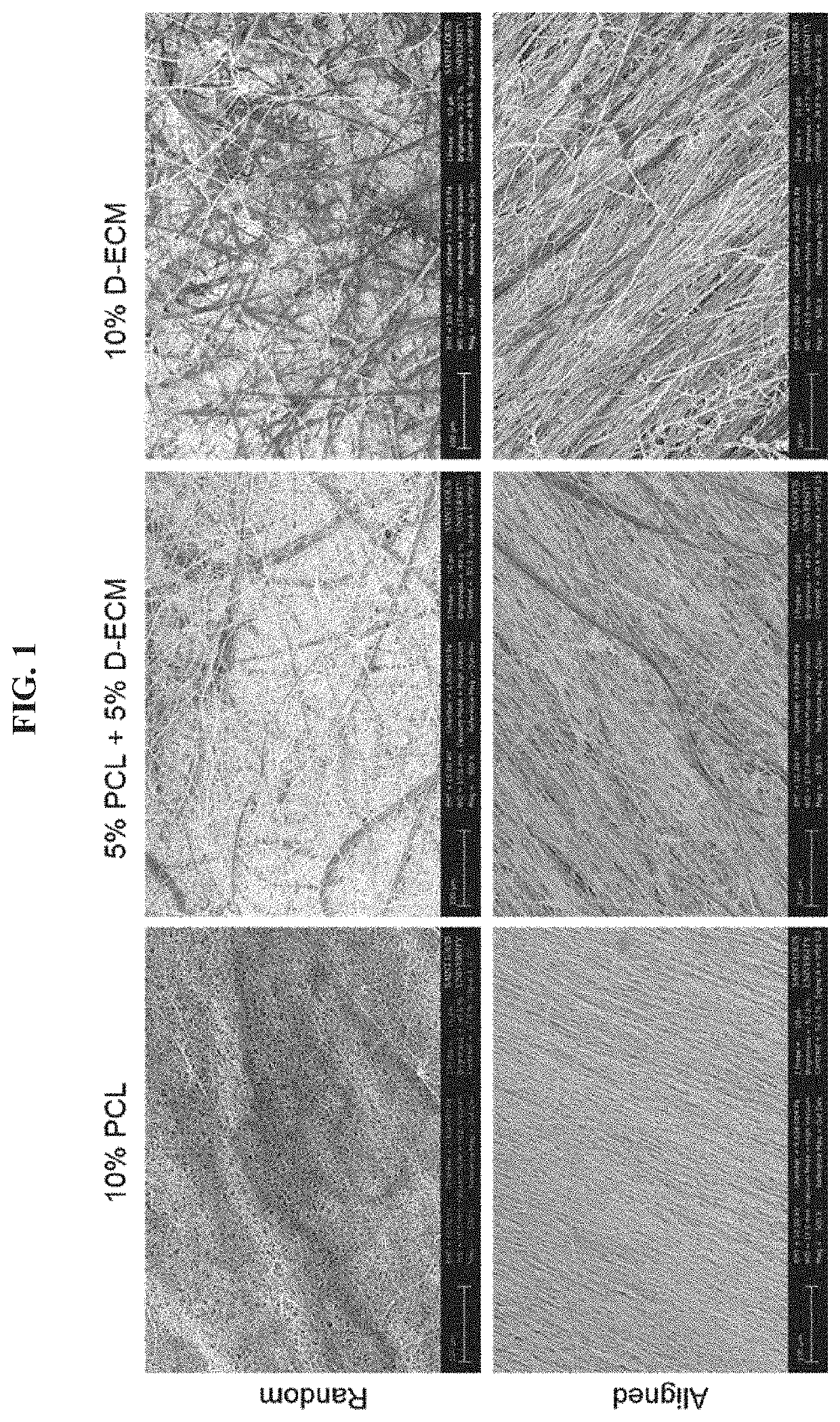Aligned electrospun matrices of decellularized muscle for tissue regeneration
a technology of electrospun matrices and muscle tissue, which is applied in the direction of prosthesis, ligaments, surgery, etc., can solve the problems of low quality of life, limb amputation, and muscle tissue is unable to repair and regenerate itself, and achieves a wide and significant impact.
- Summary
- Abstract
- Description
- Claims
- Application Information
AI Technical Summary
Benefits of technology
Problems solved by technology
Method used
Image
Examples
example 1
[0059]Decellularization of skeletal muscle and electrospinning of scaffolds
[0060]Skeletal muscle (including dorsal extensors, ventral and lateral flexors) was harvested from bovine tail. The tissue was subjected to a freeze thaw cycle following which the connective tissue and fat was removed. The muscle tissue was cut into 1 cm3 pieces and rinsed with deionized water for 24 hours at 4° C. under mechanical agitation. The tissue pieces were then stirred in decellularization solution (Triton X-100 and ammonium hydroxide (NH4OH)) for 2-3 days at 4° C. The decellularized muscle was then stirred for 24 hours in deionized water to remove the detergent. Following the decellularization protocol, the muscle tissue was frozen and lyophilized to obtain the decellularized-extracellular matrix (“D-ECM matrix”). The D-ECM matrix was then digested and solubilized with pepsin, dialyzed against DI water, lyophilized and stored frozen at −80° C. until needed. Briefly, a solution of PCL with or without...
example 2
[0064]In this Example, mechanical testing of scaffolds was determined.
[0065]Uniaxial tensile testing was performed to failure on a scaffold. ‘Dog-bone’ shaped samples were cut from the electrospun scaffold (2.65 mm wide at their narrowest point with a gage length of 10 mm) and their thicknesses were measured with a Mitutoyo Absolute 547-500 micrometer (Mitutoyo America Corporation). Samples were then tested on an MTS Criterion Model 42 testing system with a 100N load cell (MTS Systems Corp.) at an extension rate of 10.0 mm / min Elastic modulus, peak stress and strain at break were calculated by the MTS software (MTS TestSuite: TW Elite) and recorded. The results are shown in FIG. 4. The pure PCL scaffolds exhibited the highest peak load and peak stress under both dry and hydrated conditions. However, statistical significance was not observed in all cases (FIG. 5). The anisotropic PCL scaffolds showed statistically higher peak stress, peak load and modulus but lower strain at break co...
example 3
[0066]In this Example, cell response to electrospun scaffolds was determined.
[0067]Primary satellite cells were isolated from the hindlimb muscles of BALB / c mice and seeded at a density of 45,000 cells / well on 10 mm discs of electrospun scaffolds of 100% PCL, 100% D-ECM and PCL:D-ECM (50:50) in a 48 well plate. Cell seeded scaffolds were stained with desmin (abcam) and DAPI on day 4 of culture and imaged using confocal microscopy. The satellite cells were randomly distributed on the scaffolds with randomly oriented fibers. The cells were aligned end-to end on electrospun scaffolds with aligned fibers and some were found fused into multinucleated desmin+ myotubes. The hybrid 5% PCL and 5% D-ECM scaffolds had more myotubes that appeared thicker in diameter (FIG. 5). The pure 10% D-ECM scaffolds shrunk in culture media and disintegrated during the staining procedure.
[0068]The VEGF and IL-6 production was quantified in cell culture supernatants collected on days 1 and 4. Overall, the VE...
PUM
| Property | Measurement | Unit |
|---|---|---|
| diameter | aaaaa | aaaaa |
| diameter | aaaaa | aaaaa |
| pore-radius | aaaaa | aaaaa |
Abstract
Description
Claims
Application Information
 Login to View More
Login to View More - R&D
- Intellectual Property
- Life Sciences
- Materials
- Tech Scout
- Unparalleled Data Quality
- Higher Quality Content
- 60% Fewer Hallucinations
Browse by: Latest US Patents, China's latest patents, Technical Efficacy Thesaurus, Application Domain, Technology Topic, Popular Technical Reports.
© 2025 PatSnap. All rights reserved.Legal|Privacy policy|Modern Slavery Act Transparency Statement|Sitemap|About US| Contact US: help@patsnap.com



